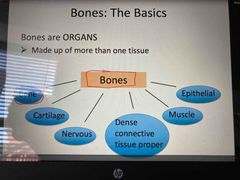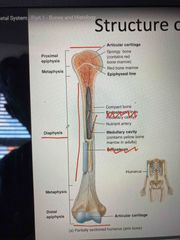![]()
![]()
![]()
Use LEFT and RIGHT arrow keys to navigate between flashcards;
Use UP and DOWN arrow keys to flip the card;
H to show hint;
A reads text to speech;
25 Cards in this Set
- Front
- Back
|
Are bones made of one type of tissues? |

No, bones are made of many tissues including the ones mentioned above. |
|
|
What are some functions of bone? |
-Support -protection -anchorage (provide attachment to muscles, act as anchors) -miniral stored inside -Blood cell formation and fat storage (in the bone marrow) -Hormone production |
|
|
What are two classifications of bone? |
-Axial (portion of bones closer to the midline, sternum, ribs, skull, etc… -Appendicular (Appendages like upper limbs, shoulder girdles, lower limb and pelvis) |
|
|
What are compact and spongy bones? |
Two different parts of the bone. Compact bone: outer layer of the bone which is tough and dense Spongy bone: internal layer of the bone. Trabeculae are stripped honeycomb-like structures on the inside. Spongy bones contain marrow. |
|
|
Explain the structure of the long bone and include the medullary cavity |

-Wider heads on both sides called epiphysis (proximal, which means closer to body or trunk and distal which is further away). -long shaft is called Diaphysis -Diaphysis contains spongy bone and the Medullary Cavity where lots of marrow is stored so it has more openings then regular spongy bone. |
|
|
What is the area between the epiphysis and diaphysis in long bones? |
It is called the Metaphysis… or growth plates and they are made of cartilage up until someone is past puberty then it fuzes |
|
|
What is the cartridge located on the epiphysis of the long bones? |
Hyaline cartilage -helps with shock absorption and softer edgeing because epiphysis connects to other bones |
|
|
What are the types of marrow? |
Two types of marrow 1. Red marrow - blood cell production -located in trabecular cavities of long and flat bones 2. Yellow marrow - Fat storage -Can turn back into red marrow in adults in severe anemia (decrease in RBC and decrease in oxygen to lungs so it converts yellow marrow to red marrow) |
|
|
What are the three types of cartilage and what is the purpose of cartilage |
1) Hyline cartilage 2) Elastic 3) Fibrocartilage -good at resisting compression, absorbs damage that would be done if two bones were to rub against eachother. |
|
|
What is Hyline cartilage and where is it found? |
-It is the most abundant cartilage in the human body. -found in costal (costal is ribs) - connecting hands and ribs -parts of the nose -the larynx and down the trachea is made of it |
|
|
What is Elastic cartilage and where can it be found? |
Cartilage type that can be bent more repeatedly. -found in external ear (can be bent easily) -found in external nose -Epiglottis, part of neck where moves when you swallow and prevents food from coming into lungs |
|
|
What is Fibrocartilage? Where is it found? |
Cartilage which has great tension strength -found in knee joint -located in areas subject to pressure and stretch |
|
|
Is there cartilage in the growing skeleton? |
Fetuses are made up of mostly Hyline cartilage -resilient and elastic -ideal for fast growth -no nerves and blood vessels -as cartilage fuses the baby starts to learn to walk and gains strength |
|
|
What is a fracture? What are the differences in fractures? |
A break In the bone. The break can be in regards to the Position of the bone: Bone can be displaced fracture which mean bone ends are out of alignment or non-displaced fracture: bone ends are still in original position Break can occur in regards to the Completeness of bone: Complete fracture: bone is completely broken through. Incomplete fracture: break in bone but not broken all the way through Skin penetration: evaluating fractures to see if skin is broken or penetrated. Closed penetration: Bone does not penetrate skin Open penetration: Bone does penetrate skin |
|
|
What is a comminuted fractured? |
Bone is splintered , crushed or broken into pieces. And particles from the bone are present |
|
|
What is a Green stick fracture? |
Common in children because they haven’t had their bones ossify and turn into bone from cartilage yet. -partial fracture where one side of bone breaks and the other side just bends |
|
|
What is an impacted fracture? |
One end of the bone forcefully driven into another end of the bone and it breaks |
|
|
What is a pott fracture? |
Ankle fracture -break in malleoli of ankle (bumpy bones on both ends of ankle) -can happen if you jump and land awkwardly or if you roll your ankle |
|
|
What is a colles fracture? |
When you fall and break your fall with your hands. -wrist is made of two main bones (radius and ulna) -colles fracture is break in radius |
|
|
Explain fracture repair for displaced bones |
Closed reduction: physician has to manually coaxes bone ends back into position Open Reduction: bone ends are secured surgically with pins or wires |
|
|
Explain how a fracture heals itself. |
1) A hematoma forms, which is basically a bunch of blood which rushes to the area 2) Fibrocartilaginous callus forms… Fibrocartiliage replaces blood. 3)Bony Callus forms - Fibrocartilige gets replaced by actual bone 4) Bone remodeling occurs - extra bone is removed and new bone is smooth. |
|
|
What are some Bone disorders? |
Osteomalacia: Soft/weak bones due to poor mineralization (Due to Cacium or Vit D) Rickets: child version of Osteomalacia -More dangerous because child is still growing and cartilage has to be converted to bone so that it can support child’s weight Osteoporosis: bone resorption (bone breakdown) is happening more then bone deposition. -Common in older adults because of the decrease in sex hormones -Treatable with Calcium, Vit D or hormone replacement therapy -Prevention: adiquite nutrition or load bearing exercise |
|
|
What is the use of the axial skeleton? |
-Forms the longitudinal axis of the body (all components of the body move around it) -Supports all structures around head neck and truck -protects brain, spinal cord and thoracic organs. |
|
|
K |
I |
|
|
What are some of the uses of the Bones of the skull? |
-Forms the framework of the face -Contain cavities for special sense organs (taste, smell, sight) -Provide openings for air and food passage -Secure the teeth -Anchor muscles of facial expression, which we use to show our feelings |

